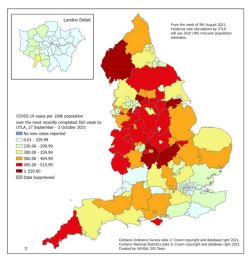Covid-19 reader: 8 October
Booster jabs – the right decision?
World Health Organization, interim statement
 Health and social care secretary Sajid Javid (pictured below) this week took to the Conservative party conference stage to talk up the country’s ‘vaccine wall of defence’. Not only had it held firm, but the government would keep strengthening it, he said, boasting of ‘one of the only national booster programmes in the world’.
Health and social care secretary Sajid Javid (pictured below) this week took to the Conservative party conference stage to talk up the country’s ‘vaccine wall of defence’. Not only had it held firm, but the government would keep strengthening it, he said, boasting of ‘one of the only national booster programmes in the world’.
The United States is also rolling out a booster programme with booster shots now reportedly outpacing first and second doses of the vaccines and 3.4% of the fully vaccinated US population now also having received the extra jab.
However, the need for such booster programmes is still not accepted by everyone around the globe. The World Health Organization this week updated its Interim statement on booster doses for Covid-19 vaccination.
It continues to say that any introduction of booster doses should be ‘firmly evidence-driven and targeted to the population groups in greatest need’. Specifically, decisions should be informed by evidence on waning vaccine effectiveness, in particular a decline in protection against severe disease in the general population and in high-risk populations, or due to a circulating variant of concern.
‘To date, the evidence remains limited and still inconclusive on any widespread need for booster doses following a primary vaccination series,’ the update said.
It also said the potential benefits of using these vaccine doses in other countries should be factored in. ‘In the context of ongoing global vaccine supply constraints, broad-based administration of booster doses risks exacerbating inequities in vaccine access by driving up demand and diverting supply while priority populations in some countries, or in sub-national settings, have not yet received a primary vaccination series,’ it added.
It concluded that the focus remains on urgently increasing global vaccination coverage with the primary series driven by the objective to protect against severe disease.
In fact, the update’s conclusion is basically unchanged since a statement was issued in August. However, the revised statement distinguishes between booster doses (administered to people who have completed a primary vaccination series and to boost falling immunity) and additional doses (for target populations where the immune response to a primary series is deemed insufficient). And it notes that WHO’s Strategic Advisory Group of Experts on Immunization will consider the evidence at a meeting in November.
Long Covid’s rising numbers
Office for National Statistics, October report
About 1.1 million people (1.7% of the population) were experiencing self-reported long Covid at the beginning of September, according to the latest report from the Office for National Statistics.
Long Covid is defined as having symptoms lasting for more than four weeks after the first suspected coronavirus infection that aren’t explained by something else. The numbers represent an increase compared to August, when an estimated 970,000 people had continuing symptoms.
This is the largest monthly increase since estimates of self-reported long Covid prevalence were first published in April. This reflects increased incidence of Covid-19 infections in the UK during July.
For three quarters of those with self-reported long Covid, the symptoms were still present at least 12 weeks after first having the virus. And for more than a third, it had been at least a year since first contracting Covid.
Two-thirds of the total said the symptoms were adversely affecting day-to-day activities, while for one in five with the condition these activities had been ‘limited a lot’.
Tiredness was the most common symptom, followed by shortness of breath, loss of smell and difficulty concentrating. Prevalence was greatest in: people aged 35 to 69; females; people living in more deprived areas; those working in health and social care; and those with another activity-limiting health condition.
Over the last year, the NHS has established 90 specialist post Covid clinics and 14 paediatric hubs. Some £94m has been invested in specialist assessment and treatment services, plus £30m to enhance primary care services. Guidance for post-Covid syndrome assessment clinics was updated in April.
In a joint report in September, the NHS Confederation and NHS Providers said that one in three trusts believed the impact of long Covid was very significant or significant with many suggesting the impact could be felt until the end of 2024/25 and beyond.
A period of stability
UK Health Security Agency, surveillance report
It is not exactly ‘all quiet’ on the coronavirus front, but national statistics do appear to show that England has entered a period of stability. The new UK Health and Security Agency’s first weekly surveillance report on flu and Covid-19, taking on the duty from the now disbanded Public Health England, said that cases remained stable or decreased in all regions, and remained stable in all ethnic groups and in most age groups.
Covid case rates were highest in those aged 10 to 19, with 1,048 cases per 100,000 across the week – although this represented a decrease from the previous week. Lowest rates were in those aged 80 and above at 86 per 100,000. Regionally the East Midlands had the highest weekly case rate at 442 per 100,000, although the Yorkshire and Humber region was also over the 400 mark. London had the lowest case rate of 197.
There was a greater range at upper tier local authority level, where six authorities broke the 520 per 100,000 barrier – worthy of the UKHSA darkest red on its Covid heat map (pictured). These included North Lincolnshire, Trafford, Northamptonshire, Warwickshire, Calderdale and Cumbria.
The hospital admission rate for the week was 5.6 per 100,000. While this is a minor increase on the previous week – up from 5.44 – the longer-term trend is down. Admissions stood at nearly 8 per 100,000 six weeks ago. However, analysis in Health Service Journal (subscription required) highlighted that the NHS in England saw five times more Covid positive patients admitted to hospital in the second quarter of 2021/22 than in the first.
Admission rates were highest in the North East, according to the UKHSA report, with a rate of just over 10 per 100,000. And the highest admission rates continue to be among those aged 85 and above.
Related content
We are excited to bring you a fun packed Eastern Branch Conference in 2025 over three days.
This event is for those that will benefit from an overview of costing in the NHS or those new to costing and will cover why we cost and the processes.